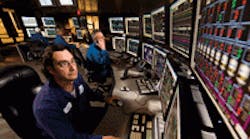When the recession struck in 2008, consumer-electronics retailer Best Buy saw its sales of LCD TVs, refrigerators and laptop computers slow to a trickle.
Offering promotions and sales incentives alone wasn't going to bring customers through the door. Instead, Best Buy's first step was taking a magnifying glass to its sales books: using the analytical capabilities of software to study customers' buying patterns and discern predictive patterns of purchasing.
Using Omniture software, Best Buy learned, for example, that 7% of its customers accounted for 43% of its sales. Furthermore, it predicted that by offering zero-interest financing on purchases involving multiple items -- as opposed to, say, just a single flat-screen TV -- sales would surge.
If business intelligence provided executives with insight, analytics attempts to provide foresight -- to not only receive alerts when a machine breaks or a plant halts its production, but to also understand how those incidents will impact the next day's production and the ramifications on the month's totals.
"Predictive analytics is becoming an advanced business intelligence," says Siddharth Taparia, a senior director for software developer SAP's BusinessObjects division. "It's become much more of an area of focus for companies that have gotten historical information, where they are getting alerts and near real-time data and now want to gaze into the crystal ball and get a sense of what might happen in the future."
That applies to a variety of applications. Maintenance data, for instance, lends itself to being extrapolated and used to predict when problems might occur or when a machine tool is most likely to need service -- down to specific parts. Or companies that are deeply reliant on raw materials, which tend to fluctuate in price, can get a sense of where those prices might be in 15 months.
Valero, the nation's largest independent oil and gas refiner, applied SAP's Manufacturing Integration and Intelligence (MII) software to its 15 refineries across the U.S. as part of a project to create greater visibility. Valero built operations control rooms at each of its facilities, with large screens that detail every point of execution status for each of its refining operations. If there is a breakdown anywhere, it can be immediately pinpointed. MII then can predict the impact of that breakdown in production loss and cost.
Of course, the software's predictions and analyses are only as good as the quality and breadth of the available data, warns Taparia. The first step, he said, is getting a company's data in order. Managers then need to target where analytics will have the greatest value, considering, for example, business processes, customers, the market and competition.
"There is no magic software that will provide you with all the answers," he says. "But what happens is your systems get trained over time as you get these fluctuations and you stabilize. That information becomes more valuable because you can recognize certain patterns."
Predictive analytics seems to be gaining momentum in the marketplace. IBM bought predictive analytics firm SPSS last July for $1.2 billion. And IDC predicts the $1.4 billion market for advanced analytics, of which predictive analytics is a subset, will grow 10% annually through 2011.
According to an Accenture survey from earlier this year, which queried 600 U.S. and U.K. companies, two-thirds of all respondents cited as a top long-term priority developing the capability to model and predict behaviors to the point where individual decisions can be made in real time, based on the analysis at hand.
"I think of analytics as connecting the plant floor to the enterprise," says Taparia, "where you have visibility into both whatever is happening on a real-time basis on your shop floor and the transactional visibility in what might happen across your supply chain. It provides context and sensitive intelligence to the people who make decisions."
So while some companies are piecing together what just happened, analytics helps decision-makers consider what's next.




